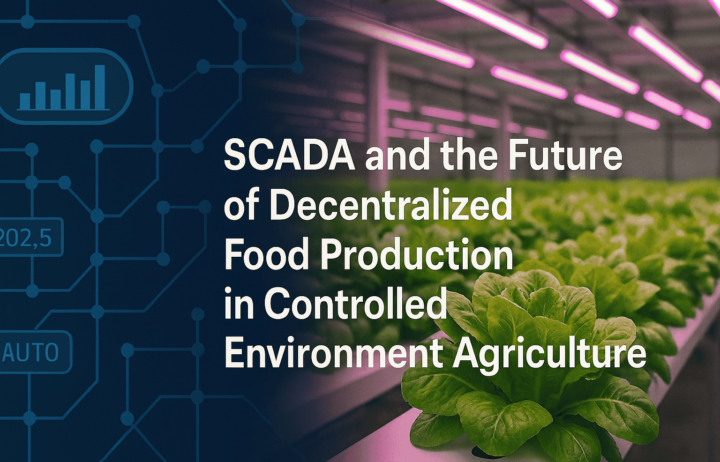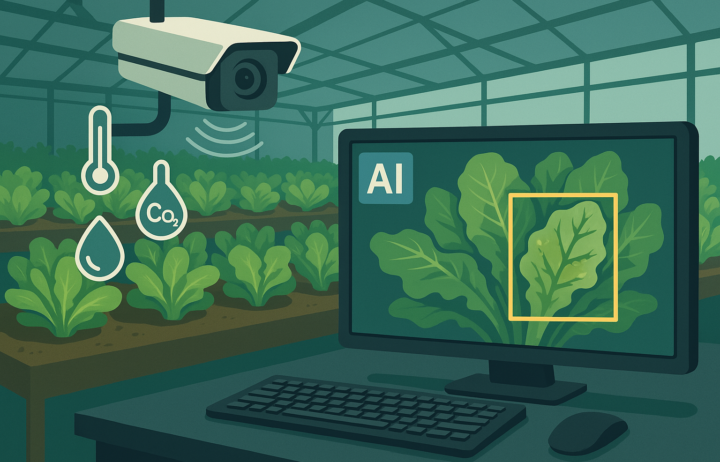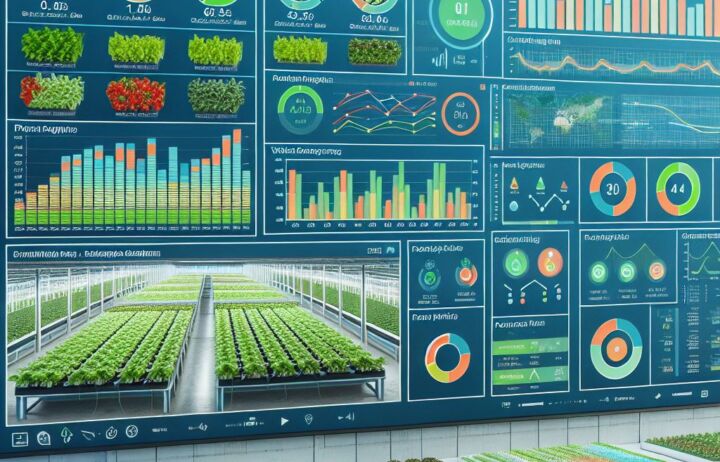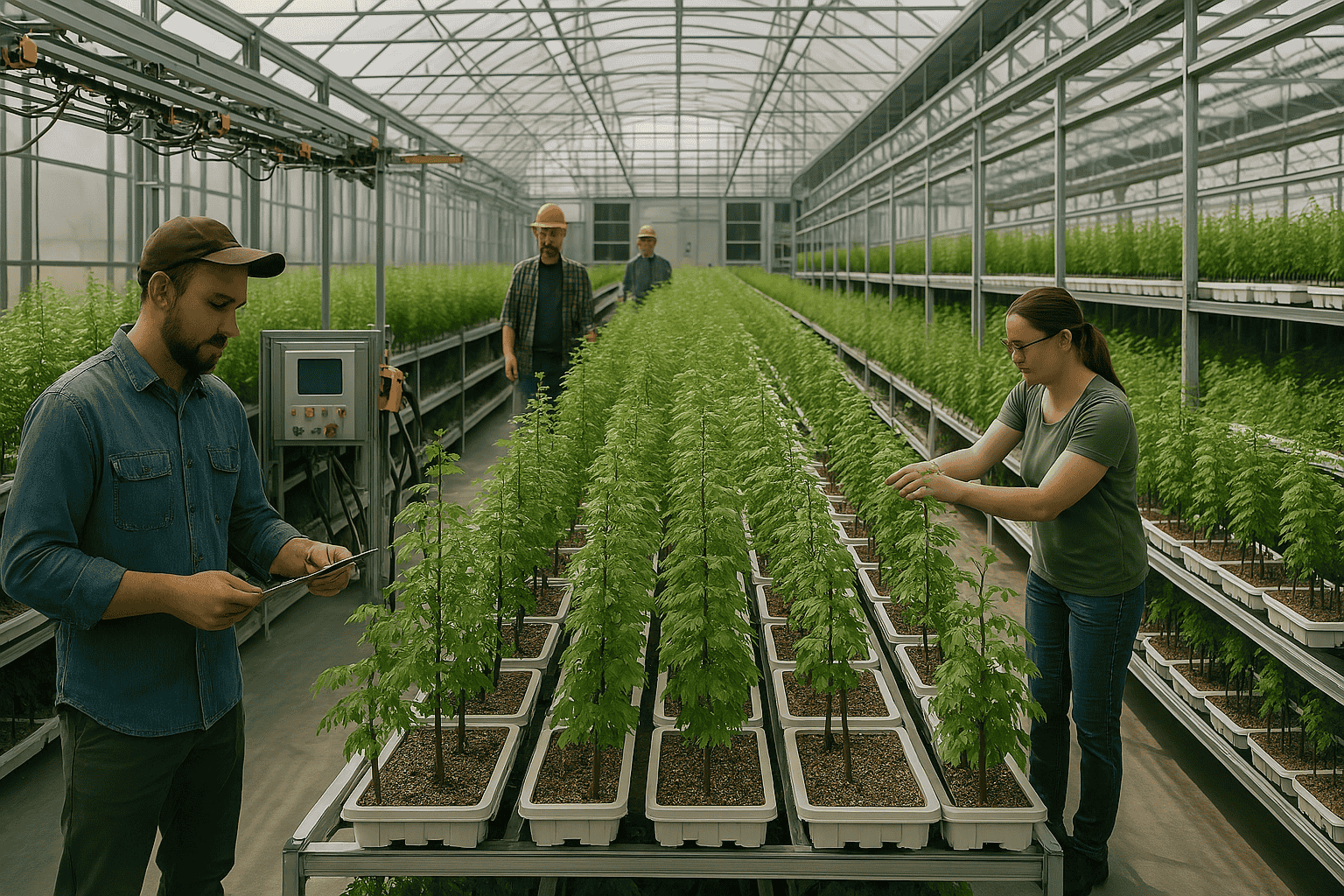
Replanting Canada: How Hydroponics Can Help Restore Forests, Strengthen Rural Economies, and Build a Greener Future
Rooted in Recovery. Powered by Innovation.
Every summer, wildfires sweep across Canadian landscapes with increasing intensity, scorching millions of hectares of forest and displacing entire ecosystems. In other areas, mining, oil extraction, and large-scale industrial development leave behind vast tracts of disturbed land—stripped of the vegetation needed to support wildlife, regulate water systems, or anchor the soil.
Canada’s need for reforestation is urgent. Yet traditional methods of tree propagation and planting often fall short. They’re slow, seasonal, labour-intensive, and unable to keep up with the scale of ecological loss we’re facing.
But what if we could rethink how we grow the forests of tomorrow?
At NuLeaf Farms, we believe that controlled environment agriculture (CEA)—specifically hydroponic propagation—has a powerful and largely untapped role to play in Canada’s reforestation strategy. By moving early-stage plant production into precision-controlled environments, we can produce healthier, more resilient trees and native vegetation, year-round, and at scale.
And perhaps even more importantly: we can use this technology to spark economic growth in rural, remote, and wildfire-affected regions—creating long-term jobs, business opportunities, and climate resilience in the very places that need it most.

Why Hydroponics for Reforestation?
Hydroponics is best known for leafy greens and herbs, but its benefits extend far beyond salads. In simple terms, hydroponics is a soilless method of growing plants using nutrient-rich water solutions. When adapted to propagate native tree species and shrubs, it offers a range of compelling advantages over conventional soil-based nurseries.
1. Accelerated Growth Timelines
Hydroponic systems allow for faster germination and stronger early-stage development. Species that traditionally take several months to establish in soil can reach transplant-ready size in a fraction of the time—sometimes up to 50% faster.
This speed matters. When post-fire or industrial landscapes are left bare for too long, they become prone to erosion, invasive species, and permanent ecological damage. Faster propagation means faster replanting—and a better chance at full ecosystem recovery.
2. Consistency and Survival Rates
Controlled environment systems remove the variables that typically challenge traditional nurseries: inconsistent temperatures, fluctuating light levels, disease pressure, and pests. The result is uniform, high-quality seedlings with stronger root systems and greater resilience when moved into natural environments.
For tree-planting organizations, this translates to higher survival rates, lower per-plant costs, and better returns on restoration efforts.
3. Year-Round Production
Canada’s short growing season has always been a bottleneck in reforestation. Hydroponics solves this. With the right infrastructure, growers can produce seedlings 12 months a year—ensuring a continuous supply for spring, summer, or fall plantings.
This is especially valuable for large-scale remediation projects that need to move quickly to meet environmental regulations or offset carbon impacts.
4. Reduced Inputs, Smaller Footprint
Hydroponic systems use up to 90% less water than conventional methods and require less space for the same output. This efficiency makes them ideal for communities where water is scarce or land for nursery expansion is limited.
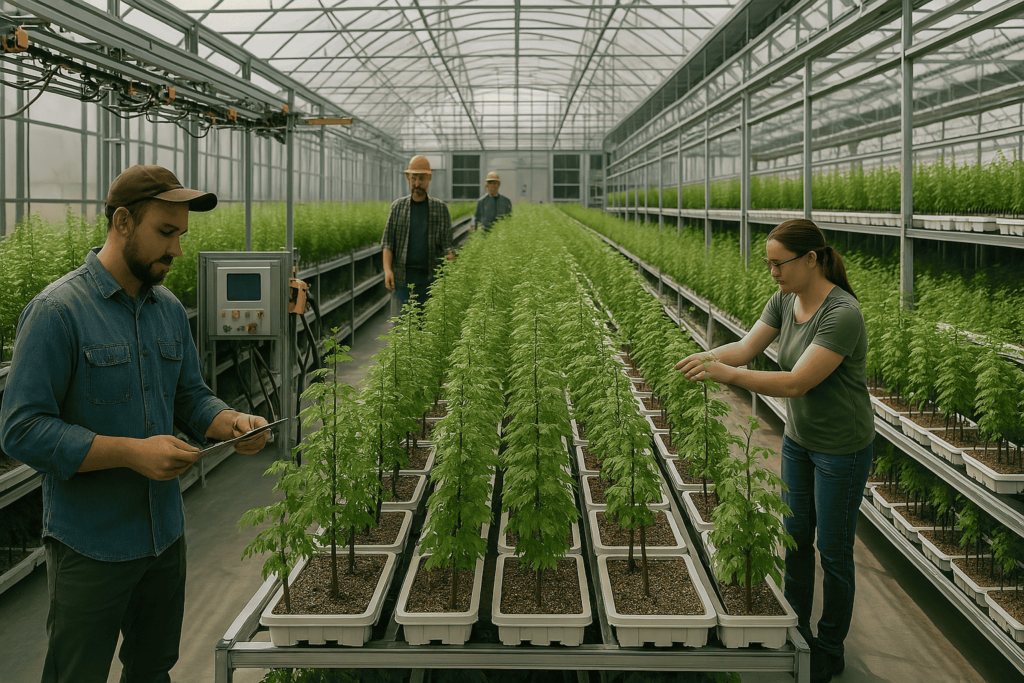
Building Local Economies Through Environmental Regeneration
The real opportunity here goes beyond the growing technology. It lies in building a circular, local economy around reforestation and land restoration—especially in rural and wildfire-impacted areas that have seen economic decline.
By establishing regionally based hydroponic propagation centers, communities can produce high-value tree and shrub seedlings to meet growing demand from:
- Government reforestation programs
- Forestry and mining companies
- Pipeline and utility developers fulfilling environmental offset requirements
- NGOs and land conservation groups
- Carbon offset project developers
Each facility creates direct employment in propagation, maintenance, and distribution—as well as secondary economic benefits for transport providers, greenhouse suppliers, and trades involved in construction and system maintenance.
In areas where traditional forestry or agriculture jobs have disappeared, this model creates a new kind of green economy—one rooted in restoration and resilience.
Buyers Are Already Lined Up
The demand for native plant stock in Canada is growing rapidly. Between federal climate goals and provincial land-use regulations, hundreds of millions of trees and shrubs are needed annually to meet reforestation targets and environmental offsets.
Who’s Buying?
- The 2 Billion Trees Program (Natural Resources Canada) alone is targeting the planting of two billion trees by 2031—most of which need to come from Canadian nurseries.
- Reclamation departments of oil and mining companies are mandated to restore disturbed land and are actively seeking native species for long-term ecological stability.
- Municipalities and regional districts are investing in green infrastructure, erosion control, and flood mitigation projects, which require native vegetation.
- NGOs, carbon credit developers, and Indigenous-led conservation organizations all need reliable, regionally adapted plant stock to meet their own project targets.
In other words: the market is not speculative. It’s already here—and it’s growing.
Government Funding Is Available
Establishing a hydroponic propagation facility requires upfront investment—but there is significant funding available to help cover equipment, technology, training, and even operating costs.
Here are just a few of the programs currently supporting this kind of work:
2 Billion Trees Program (Natural Resources Canada)
Provides funding to non-profits, Indigenous communities, municipalities, and businesses for planting and nursery development.
Agricultural Clean Technology Program
Supports the adoption of water- and energy-efficient technologies like hydroponics, with an emphasis on reducing greenhouse gas emissions.
Sustainable Canadian Agricultural Partnership (SCAP)
A five-year, $3.5 billion initiative jointly funded by federal and provincial governments to support innovation and climate-smart farming—including propagation and controlled environment systems.
Indigenous Forestry Initiative
Supports Indigenous-owned or -led businesses and communities in forestry-related economic development, including nursery infrastructure, training, and research partnerships.
Western Economic Diversification Canada & PacifiCan
These regional agencies fund community-led infrastructure projects that strengthen rural economies and create long-term employment.
A Note on Indigenous Leadership
Many Indigenous communities across Canada are already taking bold steps to reclaim and restore their traditional territories. Controlled environment propagation offers a powerful tool to support these efforts—allowing Nations to produce the trees and plants needed for land restoration, while also generating economic value and sovereignty over local ecosystems.
This is a subject worthy of its own deep dive, and we’ll be sharing a full blog on this topic in the coming weeks. But for now, it’s worth noting: the intersection of Indigenous knowledge and hydroponic propagation presents one of the most exciting, culturally grounded opportunities in the reforestation space today.

Where NuLeaf Fits In
At NuLeaf Farms, we’ve spent years perfecting the systems that make this type of scalable, sustainable propagation possible. Our Leaf & Root platform brings together automation, precision environmental controls, and real-time data optimization to create the ideal conditions for growing strong, transplant-ready vegetation.
We don’t just sell equipment—we help build the entire operational model. From initial design and funding navigation to long-term operations, we partner with communities and organizations to ensure that each facility delivers both ecological and economic returns.
If your region is exploring ways to:
- Restore fire-damaged or disturbed land
- Create local jobs in sustainable industries
- Produce your own tree and shrub stock
- Participate in government or industrial reforestation programs
…we’d love to talk.
Ready to Grow the Forests of Tomorrow?
Let’s build something that lasts. Contact NuLeaf Farms today to learn how hydroponic propagation can support your community’s environmental and economic goals.






